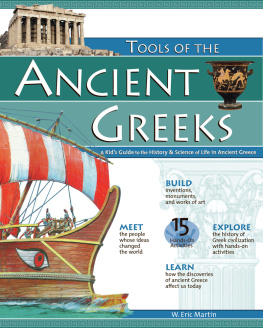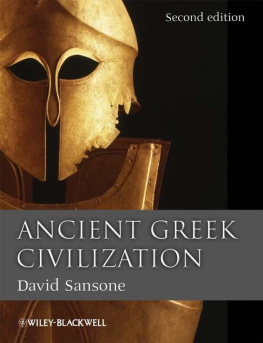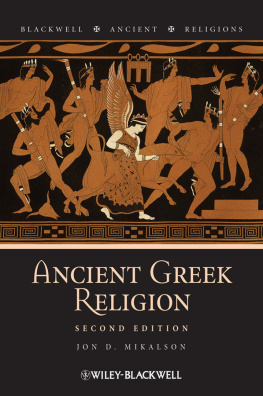
Published in 2017 by
KidHaven Publishing, an Imprint of Greenhaven Publishing, LLC
353 3rd Avenue
Suite 255
New York, NY 10010
2017 Booklife Publishing
This edition is published by arrangement with Booklife Publishing
All rights reserved. No part of this book may be reproduced in any form without permission in writing from the publisher, except by a reviewer.
Designer: Natalie Carr
Editor: Grace Jones
Cataloging-in-Publication Data Names: Cottrell, George.
Title: Ancient Greece / George Cottrell.
Description: New York : KidHaven Publishing, 2017. | Series: Unlocking ancient civilizations | Includes index.
Identifiers: ISBN 9781534520295 (pbk.) | ISBN 9781534520318 (library bound) | ISBN 9781534520301 (6 pack) | ISBN 9781534520325 (ebook)
Subjects: LCSH: Greece--Civilization--To 146 B.C.--Juvenile literature.Greece--History--To 146 B.C.-- Juvenile literature.
Classification:LCC DF77.C68 2017 | DDC 938--dc23
Printed in the United States of America
CPSIA compliance information: Batch #CW17KL: For further information contact Greenhaven Publishing LLC, New York, New York at 1-844-317-7404.
Please visit our website, www.greenhavenpublishing.com. For a free color catalog of all our high-quality books, call toll free 1-844-317-7404 or fax 1-844-317-7405.
PHOTO CREDITS
Abbreviations: lleft, rright, bbottom, ttop, ccenter, mmiddle.
Front Cover 2 Samot. 3t Haris vythoulkas. 4bl RODKARV. 4br Tatiana Popova. 5bl Faraways. 6t S-F. 6br Ververidis Vasilis. 7ml vicvic13. 7bl Georgios Kollidas. 8t Lambros Kazan. 8br ivan bastien. 9ml Anastasios71. 9tr David C Azor. 9br siete_vidas. 10t Anastasios71. 10br Michael Rosskothen. 11bl Kamira. 11br By Zde (Own work) [CC BY-SA 4.0 (http://creativecommons.org/licenses/by-sa/4.0)], via Wikimedia Commons. 12 Sergey Novikov. 13t Anastasios71. 13b mishabender. 14 KUCO. 15tr patrimonio designs ltd. 15br Voropaev Vasiliy. 16t arogant. 16-17b Malota. 17tl Vasileios Karafillidis. 18t nndrln. 20t Dimitrios. 20bl elmm. 20br Zwiebackesser. 21tr BlackMac. 21bl Georgios Alexandris. 22-23 Ververidis Vasilis. 22bl Denis Kornilov. 23br lazyllama. 24t saiko3p. 24br Paul Cowan. 25 Anton_Ivanov. 26t StockStudio. 27t Claudio Divizia. 27b Anastasios71. 28tl Anton_Ivanov. 28tm CREATISTA. 28tr Anatoly Vartanov. 28bl Offscreen. 28bm Anastasios71. 28br Anastasios71. 29tl By Zde (Own work) [CC BY-SA 4.0 (http://creativecommons.org/licenses/by-sa/4.0)], via Wikimedia Commons. 29tm lazyllama. 29tr Kite_rin. 29bl Curioso. 29bm Peter Bernik. 29br By Tony f (Own work) [CC BY 3.0 (http://creativecommons.org/licenses/by/3.0)], via Wikimedia Commons.
ANCIENT
GREECE
CONTENTS

T HE ancient Greek civilization is thought of by historians as one of the most important civilizations in history. The ancient Greeks developed many new ideas and made great progress in science, culture, and the arts. It is because of this that historians often call ancient Greece the cradle of Western civilization. This means the ancient Greeks are seen as the people who began to develop many of the ideas that are the basis of modern life and culture.
THE MYCENAEANS
The first people to rule ancient Greece were called the Mycenaeans. They ruled over mainland Greece from 1600 to 1200 BC. The Mycenaeans were great warriors and brought wealth to the area through trading. However, they eventually entered a period of decline in 1200 BC, which we now call the Dark Ages. During this time, people seemed to lose interest in wealth, culture, and technology.
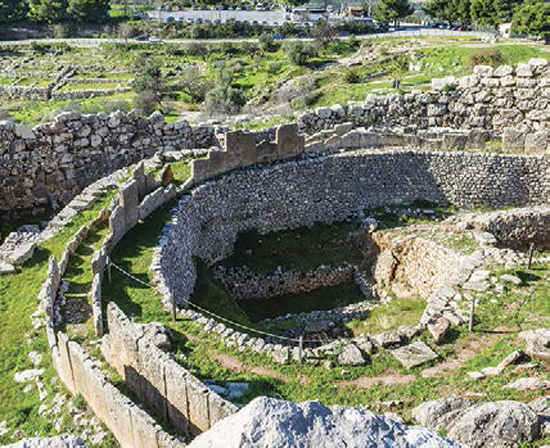
THE RUINS OF MYCENAE ARE SHOWN HERE.IT WAS AN IMPORTANT SETTLEMENT IN SOUTHERN GREECE DURING THE MYCENAEAN PERIOD.
It was the Mycenaeans who, according to the Greek poet Homer, were involved in the Trojan War. It was during this war that the famous wooden Trojan Horse was used to sneak Greek soldiers into the city of Troy.

A COPY OF THE TROJAN HORSE
THE ARCHAIC PERIOD
The Dark Ages ended around 800 BC with the start of the Archaic Period. Wealth and power returned to ancient Greece once again during this time. A system of writing, which was lost in the Dark Ages, returned and the ancient Greeks settled further across Europe than they ever had before. By 600 BC, there were Greek settlements across the Mediterranean and as far as the Black Sea, near the Middle East.

THIS STONE CARVING FROM THE ARCHAIC PERIOD SHOWS A MAN RIDING A CHARIOT.
Each Greek settlement had its own government. The country was divided up into separate city-states that were often ruled by small groups of rich noblemen. However, many people were unhappy with the noblemen, and this eventually led to a revolution and a change in the way that Greece was governed. This change introduced the idea of democracy to the world.
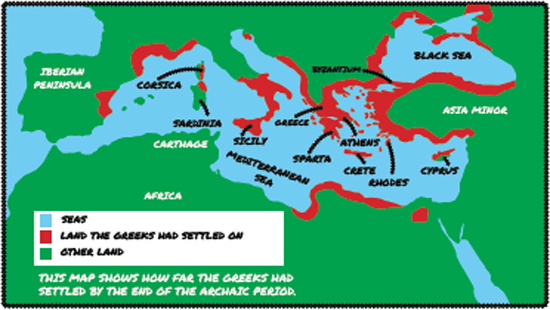
THIS MAP SHOWS HOW FAR THE GREEKS HAD SETTLED BY THE END OF THE ARCHAIC PERIOD.

THE ACROPOLIS, AN AREA IN ATHENS WHERE MANY BUILDINGS WERE BUILT DURING THE CLASSICAL PERIOD
A ROUND 500 BC, the Classical period began, and it lasted until 323 BC. This period is known for being the period of time when ancient Greece was at its strongest, both in culture and military strength. The start of the Classical period in Greece is marked by the introduction of democracy in 508 BC.

DEMOCRACY IS STILL PRACTICED BY THE GREEK GOVERNMENT TODAY.
DEMOCRACY
Even before democracy, Greek society was made up of citizens and noncitizens. Citizens were men who were born in their city, while noncitizens were women, foreigners, and slaves. Democracy gave every citizen a say in the government and was first introduced in Athens.
The introduction of democracy also brought about the use of the dikasteria. These were courts that were used to settle legal cases in ancient Greece.
The ancient Greeks used the dikasteria to hold trials using a jury made up of about 200 citizens.
The jury was picked through a process of random selection.
The Classical period in ancient Greece was also marked by many wars against foreign invaders and fighting between the Greek city-states. In 490 BC, the Persians invaded Greece, starting a period of fighting that lasted until 449 BC. Then, in 431 BC, the Peloponnesian War began. This was a series of battles between the city-states of Athens and Sparta.
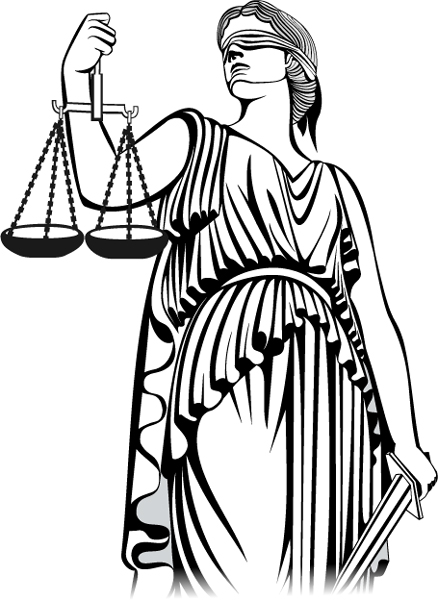
Next page
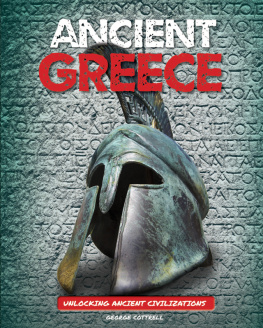
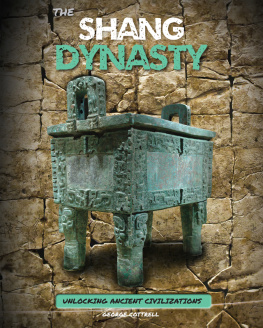
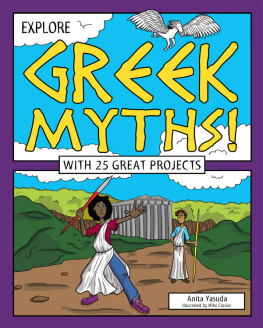


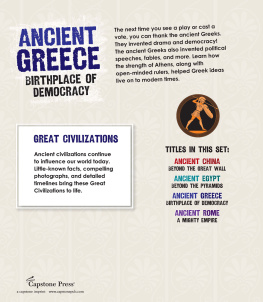
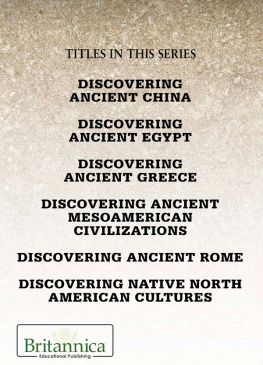
![Michael Lovano - The World of Ancient Greece: A Daily Life Encyclopedia [2 Volumes]](/uploads/posts/book/268736/thumbs/michael-lovano-the-world-of-ancient-greece-a.jpg)
